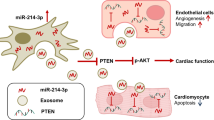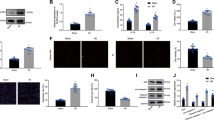Abstract
An increasing amount of evidence has suggested that microRNA (miR) plays a role in myocardial infarction (MI). Our study aimed to discuss the impact of exosomal miR-29b-3p in MI by regulating A Disintegrin and Metalloproteinase with Thrombospondin Motifs 16 (ADAMTS16). Exosomes were extracted from bone marrow mesenchymal stem cells (BMSCs). In a rat model of MI, myocardial angiogenesis and ventricular remodeling-related factors, as well as myocardial fibrosis, collagen volume fraction (CVF), capillary density, level of vascular endothelial growth factor (VEGF), and apoptosis of cardiomyocytes, were tested. ADAMTS16 and miR-29b-3p levels in the myocardial tissue of MI rats were tested. miR-29b-3p expression was decreased and ADAMTS16 expression was increased in the myocardial tissue of MI rats. ADAMTS16 was a target gene of miR-29b-3p. Upregulated miR-29b-3p delivered by BMSC-derived exosomes improved myocardial angiogenesis and ventricular remodeling, reduced myocardial fibrosis and CVF, increased capillary density and VEGF expression, and suppressed apoptosis of cardiomyocytes in MI rats. ADAMTS16 overexpression accelerated MI in rats, and ADAMTS16 upregulation reversed the protective effects of miR-29b-3p upregulation on MI rats. Our study provides evidence that upregulated miR-29b-3p delivered by BMSC-secreted exosomes can improve myocardial angiogenesis and ventricular remodeling in rats with MI by targeting ADAMTS16.






Similar content being viewed by others
References
Ghartavol, M. M., Aziz, S.G.-G., Babaei, G., Farjah, G. H., & Ansari, M. H. K. (2019). The protective impact of betaine on the tissue structure and renal function in isoproterenol-induced myocardial infarction in rat. Molecular Genetics and Genomics, 7(4), e00579.
Yang, S., Fan, T., Hu, Q., Xu, W., Yang, J., Xu, C., Zhang, B., Chen, J., & Jiang, H. (2018). Downregulation of microRNA-17-5p improves cardiac function after myocardial infarction via attenuation of apoptosis in endothelial cells. Molecular Genetics and Genomics, 293(4), 883–894.
Yang, J., Brown, M. E., Zhang, H., Martinez, M., Zhao, Z., Bhutani, S., Yin, S., Trac, D., Xi, J. J., & Davis, M. E. (2017). High-throughput screening identifies microRNAs that target Nox2 and improve function after acute myocardial infarction. American Journal of Physiology-Heart and Circulatory Physiology, 312(5), H1002–H1012.
Stromback, U., Engstrom, A., & Walivaara, B. M. (2019). Realising the seriousness—The experience of suffering a second myocardial infarction: A qualitative study. Intensive and Critical Care Nursing, 51, 1–6.
Chen, P., Pan, J., Zhang, X., Shi, Z., & Yang, X. (2018). The role of microRNA-181a in myocardial fibrosis following myocardial infarction in a rat model. Medical Science Monitor, 24, 4121–4127.
Gao, L., Liu, Y., Guo, S., Yao, R., Wu, L., Xiao, L., Wang, Z., Liu, Y., & Zhang, Y. (2017). Circulating long noncoding RNA HOTAIR is an essential mediator of acute myocardial infarction. Cellular Physiology and Biochemistry, 44(4), 1497–1508.
He, J. G., Li, H. R., Li, B. B., Xie, Q. L., Yan, D., & Wang, X. J. (2019). Bone marrow mesenchymal stem cells overexpressing GATA-4 improve cardiac function following myocardial infarction. Perfusion, 34(8), 696–704.
Yu, X., Odenthal, M., & Fries, J. W. (2016). Exosomes as miRNA carriers: Formation-function-future. International Journal of Molecular Sciences, 17(12), 2028.
Zhang, C. S., Shao, K., Liu, C. W., Li, C. J., & Yu, B. T. (2019). Hypoxic preconditioning BMSCs-exosomes inhibit cardiomyocyte apoptosis after acute myocardial infarction by upregulating microRNA-24. European Review for Medical and Pharmacological Sciences, 23(15), 6691–6699.
Li, Q., Du, X., Liu, L., Pan, Z., Cao, S., & Li, Q. (2019). MiR-126* is a novel functional target of transcription factor SMAD4 in ovarian granulosa cells. Gene, 711, 143953.
Rong, W., Yang, L., Li, C. Y., Wu, X. T., Zhou, Z. D., Zhu, W. L., & Yan, Y. (2020). MiR-29 inhibits neuronal apoptosis in rats with cerebral infarction through regulating Akt signaling pathway. European Review for Medical and Pharmacological Sciences, 24(2), 843–850.
Liu, X., Wang, M., Li, Q., Liu, W., Song, Q., & Jiang, H. (2022). CircRNA ACAP2 induces myocardial apoptosis after myocardial infarction by sponging miR-29. Minerva Medica, 113(1), 128–134.
Khanna, S., Rink, C., Ghoorkhanian, R., Gnyawali, S., Heigel, M., Wijesinghe, D. S., Chalfant, C. E., Chan, Y. C., Banerjee, J., Huang, Y., Roy, S., & Sen, C. K. (2013). Loss of miR-29b following acute ischemic stroke contributes to neural cell death and infarct size. Journal of Cerebral Blood Flow & Metabolism, 33(8), 1197–1206.
Ni, H., Li, W., Zhuge, Y., Xu, S., Wang, Y., Chen, Y., Shen, G., & Wang, F. (2019). Inhibition of circHIPK3 prevents angiotensin II-induced cardiac fibrosis by sponging miR-29b-3p. International Journal of Cardiology, 292, 188–196.
Yao, Y., Hu, C., Song, Q., Li, Y., Da, X., Yu, Y., Li, H., Clark, I. M., Chen, Q., & Wang, Q. K. (2020). ADAMTS16 activates latent TGF-beta, accentuating fibrosis and dysfunction of the pressure-overloaded heart. Cardiovascular Research, 116(5), 956–969.
Gopalakrishnan, K., Kumarasamy, S., Abdul-Majeed, S., Kalinoski, A. L., Morgan, E. E., Gohara, A. F., Nauli, S. M., Filipiak, W. E., Saunders, T. L., & Joe, B. (2012). Targeted disruption of Adamts16 gene in a rat genetic model of hypertension. Proceedings of the National Academy of Sciences of the United States of America, 109(50), 20555–20559.
Thery, C., Amigorena, S., Raposo, G., & Clayton, A. (2006). Isolation and characterization of exosomes from cell culture supernatants and biological fluids. Current Protocols in Cell Biology, 30, 3–22.
Zhang, D., Wang, B., Ma, M., Yu, K., Zhang, Q., & Zhang, X. (2019). lncRNA HOTAIR protects myocardial infarction rat by sponging miR-519d-3p. Journal of Cardiovascular Translational Research, 12(3), 171–183.
Jiang, B., Li, Z., Zhang, W., Wang, H., Zhi, X., Feng, J., Chen, Z., Zhu, Y., Yang, L., Xu, H., & Xu, Z. (2014). miR-874 inhibits cell proliferation, migration and invasion through targeting aquaporin-3 in gastric cancer. Journal of Gastroenterology, 49(6), 1011–1025.
Sugiyama, A., Mitsui, A., Okada, M., & Yamawaki, H. (2019). Cathepsin S degrades arresten and canstatin in infarcted area after myocardial infarction in rats. Journal of Veterinary Medical Science, 81(4), 522–531.
Mao, Q., Liang, X. L., Zhang, C. L., Pang, Y. H., & Lu, Y. X. (2019). LncRNA KLF3-AS1 in human mesenchymal stem cell-derived exosomes ameliorates pyroptosis of cardiomyocytes and myocardial infarction through miR-138–5p/Sirt1 axis. Stem Cell Research & Therapy, 10(1), 393.
Cheng, H., Chang, S., Xu, R., Chen, L., Song, X., Wu, J., Qian, J., Zou, Y., & Ma, J. (2020). Hypoxia-challenged MSC-derived exosomes deliver miR-210 to attenuate post-infarction cardiac apoptosis. Stem Cell Research & Therapy, 11(1), 224.
Huang, P., Wang, L., Li, Q., Tian, X., Xu, J., Xu, J., Xiong, Y., Chen, G., Qian, H., Jin, C., Yu, Y., Cheng, K., Qian, L., & Yang, Y. (2020). Atorvastatin enhances the therapeutic efficacy of mesenchymal stem cells-derived exosomes in acute myocardial infarction via up-regulating long non-coding RNA H19. Cardiovascular Research, 116(2), 353–367.
Peng, Y., Zhao, J. L., Peng, Z. Y., Xu, W. F., & Yu, G. L. (2020). Exosomal miR-25–3p from mesenchymal stem cells alleviates myocardial infarction by targeting pro-apoptotic proteins and EZH2. Cell Death & Disease, 11(5), 317.
Xue, Y., Fan, X., Yang, R., Jiao, Y., & Li, Y. (2020). miR-29b-3p inhibits post-infarct cardiac fibrosis by targeting FOS. Bioscience Reports, 40(9).
Hou, K., Li, G., Zhao, J., Xu, B., Zhang, Y., Yu, J., & Xu, K. (2020). Bone mesenchymal stem cell-derived exosomal microRNA-29b-3p prevents hypoxic-ischemic injury in rat brain by activating the PTEN-mediated Akt signaling pathway. Journal of Neuroinflammation, 17(1), 46.
Li, Z., Yi, N., Chen, R., Meng, Y., Wang, Y., Liu, H., Cao, W., Hu, Y., Gu, Y., Tong, C., Lu, M., Li, L., & Peng, L. (2020). miR-29b-3p protects cardiomyocytes against endotoxin-induced apoptosis and inflammatory response through targeting FOXO3A. Cellular Signalling, 74, 109716.
Cai, Y., & Li, Y. (2019). Upregulation of miR-29b-3p protects cardiomyocytes from hypoxia-induced apoptosis by targeting TRAF5. Cellular & Molecular Biology Letters, 24, 27.
Liang, J. N., Zou, X., Fang, X. H., Xu, J. D., Xiao, Z., Zhu, J. N., Li, H., Yang, J., Zeng, N., Yuan, S. J., Pan, R., Fu, Y. H., Zhang, M., Luo, J. F., Wang, S., & Shan, Z. X. (2019). The Smad3-miR-29b/miR-29c axis mediates the protective effect of macrophage migration inhibitory factor against cardiac fibrosis. BBA Molecular Basis of Disease, 1865(9), 2441–2450.
Zhou, S., Lei, D., Bu, F., Han, H., Zhao, S., & Wang, Y. (2019). MicroRNA-29b-3p targets SPARC gene to protect cardiocytes against autophagy and apoptosis in hypoxic-induced H9c2 cells. Journal of Cardiovascular Translational Research, 12(4), 358–365.
Drummond, C. A., Fan, X., Haller, S. T., Kennedy, D. J., Liu, J., & Tian, J. (2018). Na/K-ATPase signaling mediates miR-29b-3p regulation and cardiac fibrosis formation in mice with chronic kidney disease. PLoS ONE, 13(5), e0197688.
Funding
This work is supported by the Association Foundation Program of Yunnan Provincial Science and Technology Department and Kunming Medical University, Number of scientific research project: 2018FE001 (-285).
Author information
Authors and Affiliations
Corresponding author
Ethics declarations
Conflict of interest
The authors have no conflicts of interest to declare that are relevant to the content of this article.
Additional information
Handling Editor: Samuel S. W. Tay.
Publisher's Note
Springer Nature remains neutral with regard to jurisdictional claims in published maps and institutional affiliations.
Supplementary Information
Below is the link to the electronic supplementary material.
Rights and permissions
About this article
Cite this article
Zheng, J., Zhang, X., Cai, W. et al. Bone Marrow Mesenchymal Stem Cell-Derived Exosomal microRNA-29b-3p Promotes Angiogenesis and Ventricular Remodeling in Rats with Myocardial Infarction by Targeting ADAMTS16. Cardiovasc Toxicol 22, 689–700 (2022). https://doi.org/10.1007/s12012-022-09745-7
Received:
Accepted:
Published:
Issue Date:
DOI: https://doi.org/10.1007/s12012-022-09745-7




